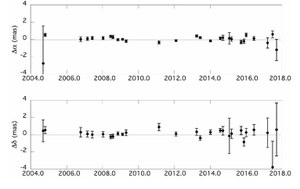VLBA Measures the Ephemeris of Saturn
 Jones et al. report results from multi-epoch radio astrometry of the Cassini spacecraft with the Very Long Baseline Array (VLBA). These observations are part of a program to determine accurate positions for the Saturn system barycenter in the inertial International Celestial Reference Frame (ICRF) and to use these position measurements to improve our knowledge of Saturn's orbit in the planetary ephemeris. The VLBA observations reported here cover the full duration of the orbital phase of the Cassini mission, from Saturn orbit insertion in 2004 to the end of mission in 2017. This period covers more than one-third of Saturn's orbital period, allowing the team to obtain good orbit constraints for Saturn, particularly on the inclination and ascending node longitude. During the early years of Cassini's orbital mission, their VLBA data dominated the determination of orbit orientation, while later in the mission range measurements become more significant. The orientation of Saturn's orbit is now known to ~ 0.25 milli-arcseconds (1.25 nrad), an order of magnitude improvement since the start of Cassini observations. Continuing improvements in the ICRF position accuracy for the phase reference sources, and possible improvements in the final orbit solutions for Cassini, may lead to a still better Saturn orbit over the coming years.
Jones et al. report results from multi-epoch radio astrometry of the Cassini spacecraft with the Very Long Baseline Array (VLBA). These observations are part of a program to determine accurate positions for the Saturn system barycenter in the inertial International Celestial Reference Frame (ICRF) and to use these position measurements to improve our knowledge of Saturn's orbit in the planetary ephemeris. The VLBA observations reported here cover the full duration of the orbital phase of the Cassini mission, from Saturn orbit insertion in 2004 to the end of mission in 2017. This period covers more than one-third of Saturn's orbital period, allowing the team to obtain good orbit constraints for Saturn, particularly on the inclination and ascending node longitude. During the early years of Cassini's orbital mission, their VLBA data dominated the determination of orbit orientation, while later in the mission range measurements become more significant. The orientation of Saturn's orbit is now known to ~ 0.25 milli-arcseconds (1.25 nrad), an order of magnitude improvement since the start of Cassini observations. Continuing improvements in the ICRF position accuracy for the phase reference sources, and possible improvements in the final orbit solutions for Cassini, may lead to a still better Saturn orbit over the coming years.
Figure caption: Post-fit residuals of Saturn’s orbit fit to the VLBA determined position for the Saturn system barycenter, in right ascension and declination.
Publication: Dayton L. Jones (Space Science Institute) et al., Very Long Baseline Array Astrometry of Cassini: The Final Epochs and an Improved Orbit of Saturn, Astronomical Journal, 159, 75 (20 January 2020).




Connect with NRAO